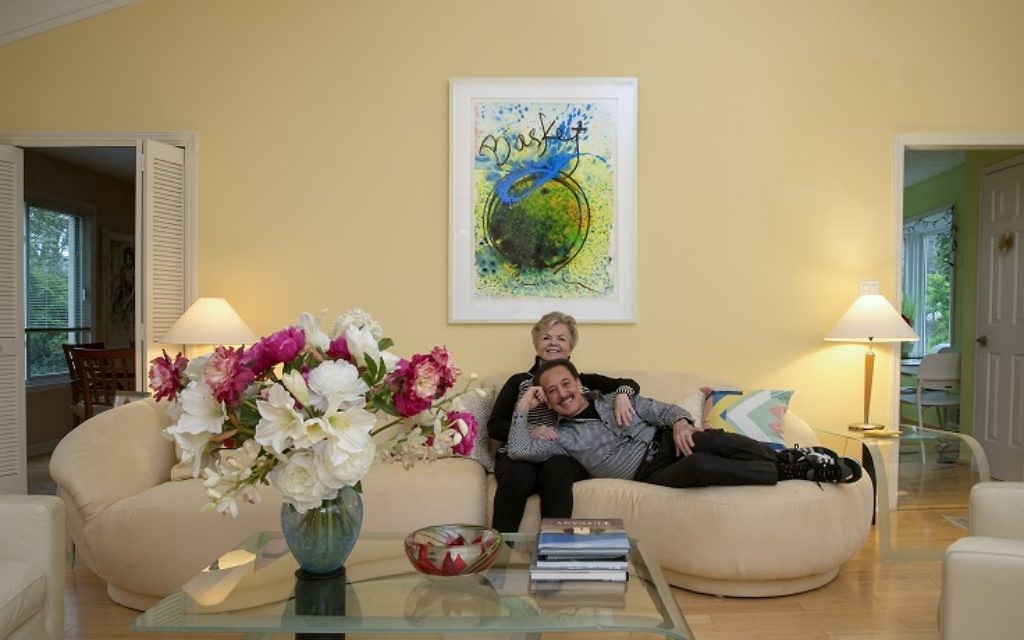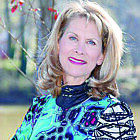Parish Kohanim’s Luminescent Trophies of Grandeur
The Jewish immigrant from Shiraz, Iran, is thriving as an artist in Atlanta.

His name is as exotic as his craft and his label as “artiste” — as in worldwide, fearless, philosophical and technical.
Parish Kohanim emigrated from Shiraz, Iran, speaking little English and carrying only $300 in his pocket. He went from Manhattan to San Francisco to his current, eponymous Buckhead three-story white-marbled studio and showroom and catapulted into a league of success with Art Basel, building lobbies, the National Black Arts Festival and ethereal painted portraitures.
Leaving his Persian Orthodox family at 18, Kohanim developed his passion and patience for producing elegant interpretations of flowers that evolve into combinations with human forms, patterns and mirrors.
Get The AJT Newsletter by email and never miss our top stories Free Sign Up

“I get bored. I keep reinventing myself. I bring out light and energy to the point of being luminescent,” he said. “There is a whole world of flowers with the inner glow that have never been seen this way before.”

A Kohanim work is not inexpensive. Everyday objects become wondrous and elevated. He said: “My clients view a piece as a timeless gift, perhaps to a loved one or to eternalize a romantic or sentimental moment. My brides are quite simply and exquisitely defined. We expend hours of work to achieve a painterly style.”
Jaffe: What was life like growing up in Iran? Were you an artistic child?
Kohanim: Iran was very different than it is now. That being said, even under the shah, there was anti-Semitism and jealousy of the success of Jews. I tolerated many snide remarks and was made to feel like a second-class citizen. This jealousy is what kept the Jews together. The Kohanim were a very devout Sephardic Orthodox family from Shiraz, a very artsy and rich-in-culture city, much like Santa Fe, N.M., is today. It was 5,100 feet above sea level. My father expected me to be a doctor or lawyer, not a starving artist.

Jaffe: How did you arrive at the merger of photography and art?
Kohanim: I came to the U.S. I knew no one. I found my major of geology to be boring. I was a busboy, then a waiter at the famous Fairmont Hotel in San Francisco. Later in New York, I interned under world-class photographer Ryszard Horowitz, a Polish Holocaust survivor featured in “Schindler’s List.”
In Atlanta I worked commercially for design firms and ad agencies and satisfied my aesthetics on the side. In 1994 I had an art gallery in Midtown. Twenty-four years ago Canon Camera approached me to join their prestigious Explorers of Light program with 50 world-class photographers like Arnold Newman, who was best known for his famous master photographic collaborations with Picasso and Igor Stravinsky at the piano.
I am still proudly a part of the program, which involves lecturing worldwide. My wife, Rosanne, is my publicist for our goal of worldwide distribution of my art. My work is in galleries in Dallas, New York, Palm Beach, Nantucket, Greenwich, Conn., and Paris.

Jaffe: What are some of the unusual projects in which you are involved?
Kohanim: I am working on a backlit LED dahlia for the new Northside Hospital doctors building. It’s a massive 24 feet by 32 feet of a flower in motion. My cobalt-blue piece (male and female) recently sold at Miami’s Art Basel. We are in the process of editing images for a 300-page, black-and-white, high-end coffee table book titled “Luminosa,” featuring Cirque du Soleil performers. … Very technical, as it was shot at one-five-thousandth of a second, which was a five-year project.

We are crafting a Loop chair designed in France by Cédric Ragot for Roche Bobois (available at its Buckhead store) where my images are embedded into the clear chairs.
Jaffe: What goes on in your three-level studio?
Kohanim: In my painterly-style portraits, final finished works represent hours of labor. We work with the top stylists and makeup artists. It may take days on the computer, montaging to create a painterly-style portrait, which will end up reproducing to a 5-foot-wide piece as a large-scale project.

Jaffe: Who are some of the artists that you collect in your own home?
Kohanim: I would describe my house as modern with warm earth tones and loads of natural light, so we can see nature. I collect sculpture by Californian Richard MacDonald, who did the bronze “Flair” sculpture for the 1996 Olympics. He uses a lost-wax technique in combination with bronze. He is quite simply known for his beauty of the human body.

My other favorites are Paige Bradley, a contemporary sculptress recognized for her spiritual and balanced works, and Robert Kipniss, known for his essential forms of trees and fields, usually in mezzotints. Also, Dale Chihuly, a household name, whose glass is often seen at the Atlanta Botanical Garden.
Jaffe: You have been compared to Georgia O’Keeffe. How would you describe your technique?
Kohanim: Photography is lacking a third dimension. I’m immersed in highlights, shadows, depth and composition. Nothing is Photoshopped. It takes time to get this dimension. I must be in a noise-free environment and in my head. Time becomes of no essence when I’m on the creative journey. I am very patient. I recently dislocated my back bending over for many long hours photographing. Nothing gets in my way.

Jaffe: How would you summarize your philosophies on both art and current politics, two disparate topics?
Kohanim: Politics — the Iran deal was a bad one. The religious government there is a disaster, stifling young people. Anyone can be thrown in jail. Art — my personal mantra is “Do your best work, and the universe takes care of you.”
Jaffe: Did your father live to see you as an unstarving artist selling individual works for five figures?
Kohanim: No, unfortunately, both my parents died early.
Jaffe: Last word — who is the most renowned person you have photographed?
Kohanim: Donald and Ivanka — that’s two!






comments